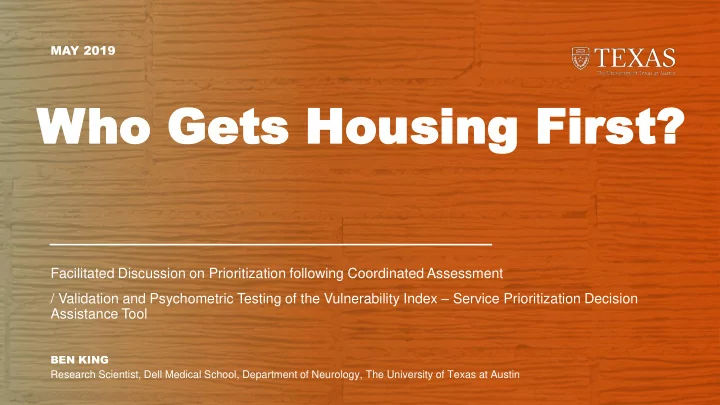

MAY 2019 Who Gets Hous ho Gets Housing Fir ing First? st? Facilitated Discussion on Prioritization following Coordinated Assessment / Validation and Psychometric Testing of the Vulnerability Index – Service Prioritization Decision Assistance Tool BEN KING Research Scientist, Dell Medical School, Department of Neurology, The University of Texas at Austin
Quick poll Does your HCH screen and/or enter Coordinated Assessments into the system?
Quick poll …Who’s a fan?
Quick poll What Coordinated Assessment prioritization tool do you use in your Continuum of Care?
Overview I. Overview II. Past Experience (discussion) III. Review of VI-SPDAT v1 evaluation 1. Measurement Domains (discussion) 2. Dimensions of Vulnerability (discussion)
Overview IV. Equity in Prioritization 1. Factor Analysis • Measurement Domains (discussion) 2. Equity • Drivers of disparity (discussion) 3. Crowd sourcing solutions (discussion)
Discussion What has your experience been like in regard to the Coordinated Assessments?
Discussion Big Picture: What are your concerns with the way Coordinated Assessment works? What does the perfect system for prioritization look like?
Discussion Do you notice a pattern in who gets housing now?
Discussion Describe a patient who got a low score, but you felt should have been higher priority for housing. What made them higher priority in your mind?
Review Prioritization tools • VI-SPDAT v1, v2 • Individual scores developed by community (VAT, B-DAT , Houston’s HPT, etc.)
Review
Review • History • Behavioral Model of Vulnerable Populations
Evaluation of the VI-SPDAT v1 • Aim 1: Test-retest, Internal consistency, Factor analysis; • Aim 2: Concurrent validation with Medical records; • Aim 3: Between group differences, Modeling the total score, Modeling eventual placement into housing;
Major findings • Non-significant internal consistency within domains identified by v1 (and v2) • Proportional Odds Assumption fails at every interval (both versions) • Exploratory and Confirmatory Factor Analysis
VI-SPDAT v1 Mental Health Factor analysis Vulnerability Utilization Substance Use Social Network
VI-SPDAT v1 Mental Health 0.537 err = 0.102 Confirmatory Factor Substance Use 0.104 Vulnerability Analysis err = 0.016 1.026 err = 0.679 RMSEA = 0.042 Social pRMSEA<.05 = . Network CFI = 0.891 SRMR = 0.038 err = 0.368 CD = 0.818
Discussion Forget the word ‘Vulnerability’ for a minute: What domains or issues would you like to prioritize?
Discussion What does ‘Vulnerability’ mean to you? What are the components or building blocks that you think comprise ‘Vulnerability’?
Major findings Concurrent /criterion validation (Aim 2) • In general, HIE > EMR in estimated prevalence – Specificity > Sensitivity • HIV/AIDS: 88.4% sensitivity and 98.0% specificity – AUC: 0.932 • HCV: 86.5% sensitivity, 82.9% specificity – AUC: 0.947 • Problematic drug or alcohol use: 70.4% sensitivity, 53.3% specificity – AUC: 0.619
Discussion Are there other ways that we can assess someone’s ‘Vulnerability’ without asking them directly, in-person?
Differences by Race Whites scored ~1 point higher on the VI-SPDAT Non-White individuals were: • more often homeless for greater than 2 years, • less likely to use healthcare services, sleep in a shelter, have been forced or tricked into things, been attacked, to harm self or others, have negative social influences, or to owe someone money, • less likely to report most health conditions, substance misuse behaviors, mental health conditions • more likely to have any income, • more likely to report history of HIV/AIDS or TB;
Differences by Ethnicity Hispanic individuals were: • younger, • less often veterans, • less likely to report having income, problematic substance use or have relapsed after treatment, • less likely to report emphysema, heart disease, or frostbite/hypothermia, • more likely to visit ED for care and report having diabetes and cancer;
Differences by Gender Female individuals were: • younger, • homeless more often, but for less time, • they use ED and crisis services more often, • more likely to be attacked, forced or tricked to do things, owe someone money, have negative social influences, have asthma and mental health conditions, • less likely to report substance misuse, have legal issues, or report histories of infectious diseases, frostbite, brain injury;
Major findings (Aim 3) • Racial disparities in total score did not lead to faster or greater placement in housing • BUT race did predict increased % of Whites placed in PSH vs RRH relative to non-Whites
Discussion What are some reasons we might see unequal effects from using a standard prioritization tool?
Drivers of Disparity: My 4 Theories • Disparities reflect real differences in “vulnerability” • Cultural competency limitations of data collectors • Self-report bias / Health literacy limitations • Measurement error (group model variance)
More major findings • Total VI-SPDAT score was best modeled by 13/50 questions • Total VI-SPDAT score did not predict eventual placement in housing (in Travis County)
Housing placement Associated with housing placement: 14. Is there anybody that thinks you owe them money? 15. Do you have any money coming in on a regular basis? 17. Do you have planned activities each day other than just surviving that bring you happiness and fulfillment? 38. Have you used non-beverage alcohol in the past 6 months? 44. Any visit with mental health provider past 6 months? Inversely associated with housing placement: 21. Does not seek healthcare 46. Learning disability /developmental disability 42. Hospitalization for mental health issue against your will 49. Not taking prescribed medication for any reason
Discussion How would you improve the housing wait-list prioritization system if you were in charge?
Recommend
More recommend